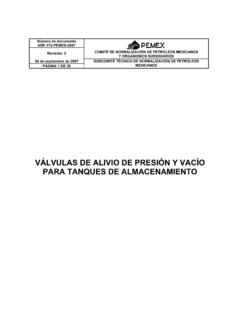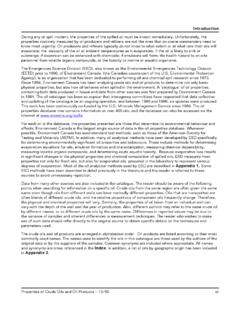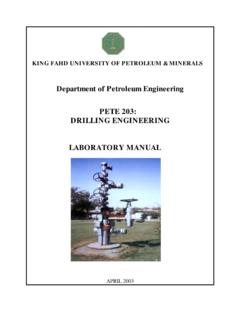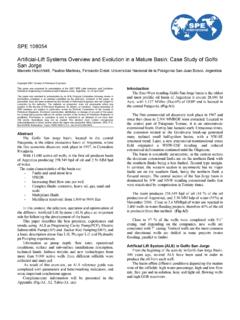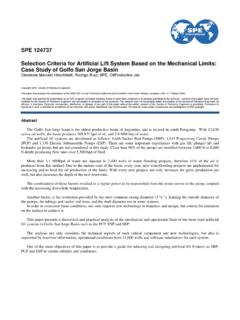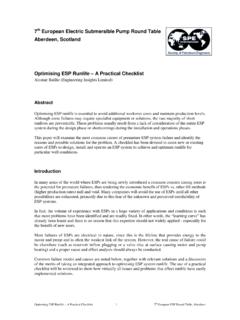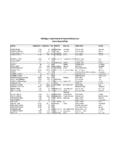Transcription of 32:(5 ()),&,(1&< 2) 68&.(5 52’ 3803,1* - OilProduction
1 Gabor Takacs, PhD +HDG 3 HWUROHXP (QJLQHHULQJ 'HSDUWPHQW 8 QLYHUVLW\ RI 0 LVNROF 32:(5 ()),&,(1&< 2) 68&.(5 52' 3803,1* $%675$&7 The paper investigates the power conditions of sucker-rod pumped installations. The power losses occurring in a rod pumping system are detailed and are grouped in surface and subsurface losses. The system s overall energy efficiency is defined and is broken into its constituent parts. After a detailed evaluation of the possible energy losses, a three-term formula is proposed in which the most important term is the lifting efficiency that describes the downhole energy losses in the rod-pumped well. When evaluating the energy efficiency of sucker-rod pumped installations, the calculation of the rod pump s useful power plays a decisive role. The paper shows that the formula most often used in the industry may give inconsistent results under the same conditions.))
2 This is why a new formula is proposed that properly describes the useful power exercised by the downhole pump and represents the minimum power requirement for lifting the given amount of liquid to the surface. Through worked examples, the paper shows the advantages of using the proposed formula and recommends its future use for the calculation of the rod pumping system s power efficiency. ,1752'8&7,21 On average, two-thirds of the world s oil wells are produced by sucker rod pumping installations. Therefore, it is of utmost importance to ensure that these systems work at their peak efficiencies. Thus, calculating the energy efficiency of sucker-rod pumping is a very important task of the production engineer. To accomplish this task, one has to define the in-, and output powers of the system and the different kinds of losses occurring in the various parts of the downhole and surface equipment.
3 A review of the literature on the subject revealed that the useful power of the sucker rod pump is calculated by a widely accepted formula that gives inconsistent results. The formula, of which several variants are known, predicts different powers under the same conditions on the same well if the wellhead pressure is varied. Since this behavior does not allow the comparison of different scenarios, the need for a standardized calculation model clearly exists. 32:(5 )/2: ,1 7+( 52' 3803,1* 6<67(0 The economy of a sucker-rod pumping system or any other type of artificial lift installation can best be evaluated by considering the lifting costs in monetary units per volume of liquid lifted. Since most of today s rod pumping installations are driven by electric motors, part of the operating costs is represented by the electric power bill.))
4 Because of the worldwide trend of increasing electric power prices, this single item has become the most decisive constituent of operating expenditures in sucker-rod pumped fields. Consequently, the never-ending pursuit of operating cost reduction can be translated to the reduction of energy losses both downhole and on the surface. The power consumed by the pumping unit s motor comprises, in addition to the energy required to lift well fluids to the surface, all the energy losses occurring in the well and in the surface machinery. Therefore, any efforts to reduce these losses should start with a perfect understanding of their nature and magnitude. )LJ and the following discussion present the possible sources of energy losses along the wellstream s flow path, grouped into downhole and surface loss categories.
5 , 2 3 The rod pumping system's useful output work is done by the downhole pump when it lifts a given amount of liquid from the pump setting depth to the surface. This work is usually described by the so-called hydraulic power, Phydr, and can be calculated as the increase in potential energy of the liquid pumped. As will be detailed later, several formulae of different merit are available to calculate this hydraulic power and this paper proposes a comprehensive equation that eliminates the many discrepancies previous models exhibited. At the other end of the rod pumping system, the electric prime mover takes the required power from the surface power supply, that power being accurately measured. Since actual power requirements at the motor vary within the pumping cycle, an average input power value, Pe, valid for one pumping cycle is found from power meter readings.
6 This power covers all requirements of the pumping system including the useful power used for fluid lifting and all energy losses occurring in the downhole and surface systems, and it represents the total energy input to the system. ' / The sources of downhole energy losses are the pump, the rod string, and the liquid column in the tubing string where irreversible mechanical as well as hydraulic losses take place. 3 XPS /RVVHV 0 HFKDQLFDO IULFWLRQ between the sucker-rod pump s barrel and plunger is usually unknown and can only be estimated. +\GUDXOLF ORVVHV in improperly sized valves, especially when pumping highly viscous crudes, can increase downhole losses. /RVVHV LQ WKH 5RG 6 WULQJ 0 HFKDQLFDO IULFWLRQ takes place wherever the rod string, while reciprocating in the tubing, rubs against the tubing inside wall, significantly increasing the energy losses in highly deviated or crooked wells or in wells experiencing rod buckling.
7 The 35+3'RZQKROH(QHUJ\/RVVHV )ULFWLRQ +\GUDXOLF6 XUIDFH /RVVHV 0 HFKDQLFDO (OHFWULFDO,QSXW 3 RZHU3 2 XWSXW3 RZHU3 ! " )LJ (QHUJ\ IORZ LQ WKH VXFNHU URG SXPSLQJ V\VWHP magnitude and severity of these frictional forces cannot accurately be determined, only estimates based on the well s inclination data can be made. 0 HFKDQLFDO IULFWLRQ in the stuffing box is usually minimal, but extreme conditions (a dried-out or too tight stuffing box) may increase its magnitude. Losses in the Liquid Column. )OXLG IULFWLRQ in the tubing-rod annulus adds to the irreversible losses because the pump action must overcome the resulting pressure differential between the pump setting depth and the wellhead. Since transient flow in an eccentric annulus is involved and the size of the annulus changes with depth in wells with tapered rod strings, accurate calculation of the frictional pressure drop, as well as the energy losses is practically impossible.
8 :HOOKHDG SUHVVXUH imposes an additional power loss on the downhole pump that, by nature, cannot be considered a part of the useful work performed on the well fluid. 'DPSLQJ IRUFHV oppose the movement of the rod string because well fluids impart a viscous force on the rods outside surface. 6 # $ / % & ' On the surface, energy losses occur at several places from the polished rod to the prime mover s electrical connections. These can be classified according to their occurrence as mechanical losses in the drive train (pumping unit, gearbox and V-belt drive), and losses in the prime mover. /RVVHV LQ WKH 'ULYH 7 UDLQ 0 HFKDQLFDO IULFWLRQ in the pumping unit s structural bearings is usually very low, provided the unit is properly maintained. 0 HFKDQLFDO IULFWLRQ in the gearbox occurs between well-lubricated gear surfaces, therefore power losses in the gearbox are usually low.
9 0 HFKDQLFDO IULFWLRQ in V-belts and sheaves causes a minimal power loss if the right size sheaves with the proper number and tightness of V-belts are used. Prime Mover Losses. 0 HFKDQLFDO ORVVHV due to friction occur in the structural bearings of the electric motor. :LQGDJH ORVV is consumed by the cooling air surrounding the motor s rotating parts. (OHFWULFDO ORVVHV include iron (or core) and copper losses, of which the decisive is copper loss, resulting in the heating of the motor and is proportional to the square of the current drawn. 3 ( (# # )$)* $)* ,QWURGXFWLRQ If the in-, and output powers of the pumping system are known from actual measurements, an overall efficiency for the pumping system can easily be defined. Since the system's useful work is represented by the hydraulic power spent on fluid lifting, and the total energy input equals the measured electric power, the rod pumping system s energy efficiency is found from: +.
10 -'/102-243+6533=K where: hsystem = overall energy efficiency of the pumping system, - Phydr = hydraulic power used for fluid lifting, HP Pe = electrical power input at the motor s terminals, HP In systems where energy losses of different nature in various system components are involved, the system s total efficiency can be broken down into individual efficiencies representing the different points in the energy flow. Total or overall system efficiency is then calculated as the product of the constituting efficiency items. In our case, one would have to assign separate efficiency figures to all or many of the individual kinds of energy losses detailed before, as was done by Lea et al. [ 1 ]. In this approach, it is necessary to designate efficiencies for the effects of: the rod-tubing friction, the fluid friction in tubing, etc.
